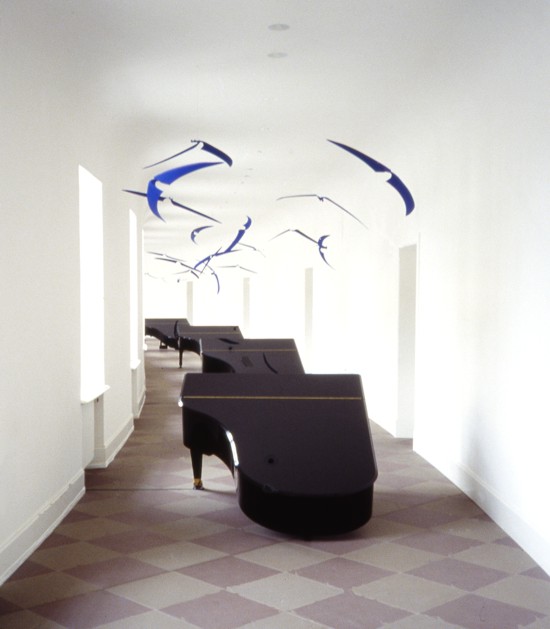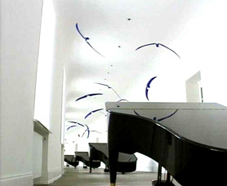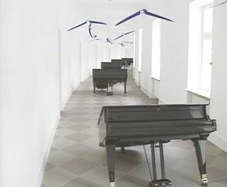


The work was developed in a shared process by both artists. If one allows oneself, accompanied by the music, to be led, pass the grand pianos, along the apparently endless corridor, it can be seen as a poetic piece. It can also be understood as a great arc of suspense stretching from the beginnings of mankind until today, raising the question about the meaning of human existence through the ages.
Gino Tavernini works with symbols and colours. Death, liveliness, lightness, contemplation and the longing for not-doing are all elements present. Their symbolic content is nonetheless not intrusive, but offers itself with room for interpretation. When walking along the corridor, one experiences the dynamic relationships of the elements through their spatial dimension. The movement of the viewer is an intentional component of the installation.
Ingo Ahmeis uses the most modern computer technology and inconspicuous segments of Johann Sebastian Bach's "Art of Fugue” in the musical component of the work. He playfully combines two sequences out of "canone per augmentationem in motu contrario" (canon in contrary motion and extension). This synthetic product then becomes the point of departure for a meta composition. The music plays, so to say as a sort of multidimensional perpetuum mobile, from seven constantly changing points in space-time. Thereby it goes through - canonically shifting them - all 13 intervals of octaval possibilities. The cycle restarts about every 12 minutes. The musical material, in this new estranged form, can be understood as a lovingly distanced quotation, which grants the optical and spatial components a further dimension: the music, and with it the whole installation, is perceived as constantly changing.
Materials: grand pianos, scythes, loudspeakers, computer.
Gino Tavernini works with symbols and colours. Death, liveliness, lightness, contemplation and the longing for not-doing are all elements present. Their symbolic content is nonetheless not intrusive, but offers itself with room for interpretation. When walking along the corridor, one experiences the dynamic relationships of the elements through their spatial dimension. The movement of the viewer is an intentional component of the installation.
Ingo Ahmeis uses the most modern computer technology and inconspicuous segments of Johann Sebastian Bach's "Art of Fugue” in the musical component of the work. He playfully combines two sequences out of "canone per augmentationem in motu contrario" (canon in contrary motion and extension). This synthetic product then becomes the point of departure for a meta composition. The music plays, so to say as a sort of multidimensional perpetuum mobile, from seven constantly changing points in space-time. Thereby it goes through - canonically shifting them - all 13 intervals of octaval possibilities. The cycle restarts about every 12 minutes. The musical material, in this new estranged form, can be understood as a lovingly distanced quotation, which grants the optical and spatial components a further dimension: the music, and with it the whole installation, is perceived as constantly changing.
Materials: grand pianos, scythes, loudspeakers, computer.
STEINZEIT
Stone Age
1992
Akademie Schloss Solitude,Stuttgart.
Space and sound installation by
Gino Tavernini and Ingo Ahmels
Stone Age
1992
Akademie Schloss Solitude,Stuttgart.
Space and sound installation by
Gino Tavernini and Ingo Ahmels